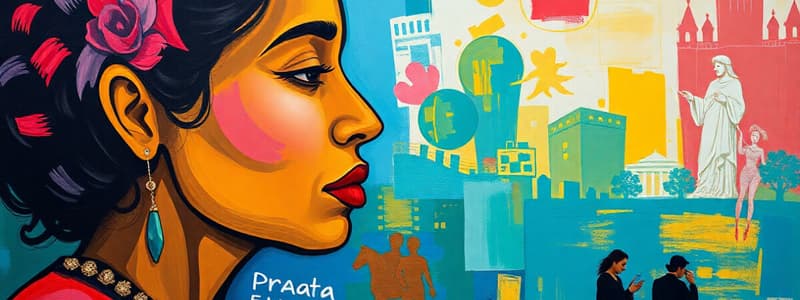Podcast
Questions and Answers
What does Gogol Ganguli's name primarily symbolize in the context of Cultural Identity?
What does Gogol Ganguli's name primarily symbolize in the context of Cultural Identity?
- The conflict between his Indian heritage and American identity (correct)
- His aspirations for success in America
- His family's traditional values
- His connection to American culture
Which character represents the traditional Indian values in contrast to American societal norms?
Which character represents the traditional Indian values in contrast to American societal norms?
- Sonia Ganguli
- Gogol Ganguli
- Maxine Ratliff
- Ashoke Ganguli (correct)
How does Gogol's journey reflect his personal transformation throughout the narrative?
How does Gogol's journey reflect his personal transformation throughout the narrative?
- He maintains a constant identity without any evolution.
- He resists any change and remains estranged from his family.
- He embraces his cultural heritage through his name change. (correct)
- He learns to abandon his Indian roots completely.
What aspect of the immigrant experience is most central to the characters in The Namesake?
What aspect of the immigrant experience is most central to the characters in The Namesake?
How does the generational gap affect family dynamics within the Ganguli family?
How does the generational gap affect family dynamics within the Ganguli family?
In what way does Ashima's character demonstrate personal growth?
In what way does Ashima's character demonstrate personal growth?
What do Gogol and Sonia's choices signify about the immigrant experience?
What do Gogol and Sonia's choices signify about the immigrant experience?
Which theme is prevalent in the characters' search for identity throughout The Namesake?
Which theme is prevalent in the characters' search for identity throughout The Namesake?
What does the contrast between Calcutta and suburban America highlight in the story?
What does the contrast between Calcutta and suburban America highlight in the story?
Which of the following statements best encapsulates the theme of belonging in The Namesake?
Which of the following statements best encapsulates the theme of belonging in The Namesake?
What leads to Gogol's initial rejection of his name?
What leads to Gogol's initial rejection of his name?
Which of the following best exemplifies the tension between Indian traditions and American ideals in the novel?
Which of the following best exemplifies the tension between Indian traditions and American ideals in the novel?
During his personal transformation, what does Gogol ultimately come to appreciate about his name?
During his personal transformation, what does Gogol ultimately come to appreciate about his name?
How does the theme of isolation manifest in the Ganguli family's experience in America?
How does the theme of isolation manifest in the Ganguli family's experience in America?
What factor most significantly influences Gogol's relationships as he matures?
What factor most significantly influences Gogol's relationships as he matures?
Which character's experience highlights the challenges of maintaining cultural traditions in a new environment?
Which character's experience highlights the challenges of maintaining cultural traditions in a new environment?
What does the relationship between Gogol and Sonia reveal about generational differences in cultural expectations?
What does the relationship between Gogol and Sonia reveal about generational differences in cultural expectations?
What narrative element best illustrates the conflict between personal freedom and family obligations?
What narrative element best illustrates the conflict between personal freedom and family obligations?
Which aspect of Gogol's character development is most impacted by his experiences in America?
Which aspect of Gogol's character development is most impacted by his experiences in America?
What is the primary literary structure used in the narrative of the coming-of-age novel?
What is the primary literary structure used in the narrative of the coming-of-age novel?
Which theme most significantly addresses the complexities faced by the protagonist in balancing heritage and aspirations?
Which theme most significantly addresses the complexities faced by the protagonist in balancing heritage and aspirations?
How do generational differences manifest in the relationships between immigrant parents and their American-born children?
How do generational differences manifest in the relationships between immigrant parents and their American-born children?
Which aspect of family dynamics is emphasized regarding Gogol's relationship with his parents?
Which aspect of family dynamics is emphasized regarding Gogol's relationship with his parents?
What does the use of the Bengali language symbolize in the characters’ immigrant experience?
What does the use of the Bengali language symbolize in the characters’ immigrant experience?
Which theme most heavily examines the emotional consequences of leaving one’s homeland?
Which theme most heavily examines the emotional consequences of leaving one’s homeland?
Which facet of cultural heritage is highlighted through the characters’ participation in traditions and festivals?
Which facet of cultural heritage is highlighted through the characters’ participation in traditions and festivals?
How does the narrative style enhance the complexity of perspectives in the story?
How does the narrative style enhance the complexity of perspectives in the story?
What is a primary consequence of cultural displacement experienced by the characters?
What is a primary consequence of cultural displacement experienced by the characters?
What role does family play in the context of Gogol’s identity formation?
What role does family play in the context of Gogol’s identity formation?
How does the non-linear timeline influence the reader's understanding of identity in the narrative?
How does the non-linear timeline influence the reader's understanding of identity in the narrative?
What does the symbolism of trains primarily illustrate in the story?
What does the symbolism of trains primarily illustrate in the story?
Which aspect of cultural heritage significantly impacts the Ganguli family's emotional connections?
Which aspect of cultural heritage significantly impacts the Ganguli family's emotional connections?
Which theme best captures the essence of Gogol's internal struggle with his identity?
Which theme best captures the essence of Gogol's internal struggle with his identity?
How do family gatherings serve the narrative in relation to cultural dynamics?
How do family gatherings serve the narrative in relation to cultural dynamics?
Which character's narrative best exemplifies the challenges associated with maintaining cultural traditions?
Which character's narrative best exemplifies the challenges associated with maintaining cultural traditions?
Which literary element most effectively conveys the emotional intricacies of the immigrant experience?
Which literary element most effectively conveys the emotional intricacies of the immigrant experience?
What primary conflict does Gogol's name change reflect in his journey?
What primary conflict does Gogol's name change reflect in his journey?
Which aspect of Gogol's immigrant experience highlights feelings of nostalgia and displacement?
Which aspect of Gogol's immigrant experience highlights feelings of nostalgia and displacement?
How does the theme of alienation manifest in the character of Ashima?
How does the theme of alienation manifest in the character of Ashima?
Flashcards are hidden until you start studying
Study Notes
The Namesake by Jhumpa Lahiri
Cultural Identity
- Explores the struggles of first-generation immigrants.
- Characters grapple with a dual identity: Indian heritage vs. American culture.
- Gogol Ganguli's name symbolizes his conflict with cultural identity.
- Themes of belonging and alienation are prevalent; characters seek to reconcile their cultural backgrounds.
East Vs. West
- Contrasts traditional Indian values with modern American societal norms.
- The setting shifts between Calcutta and suburban America, highlighting cultural differences.
- Characters embody differing responses to cultural expectations:
- Ashoke and Ashima maintain traditional practices.
- Gogol and Sonia adopt more liberal, Western lifestyles.
- Examines the challenges of adapting to a new culture while preserving one's roots.
Personal Transformation
- Gogol's journey from estrangement to acceptance of his heritage.
- His name change from Gogol to Nikhil reflects his desire for self-identity.
- Personal growth is tied to experiences and relationships, including those with family and romantic partners.
- Ashima's transformation from a reserved immigrant to an independent woman in America.
Immigration Experiences
- Depicts the immigrant experience through the lens of the Ganguli family.
- Highlights feelings of isolation, nostalgia, and homesickness.
- The impact of cultural displacement is central to the characters' lives.
- Explores the complexities of adapting to a new environment while holding onto cultural traditions.
Family Dynamics
- Emphasizes the role of family in shaping identity and values.
- The generational gap between immigrant parents and their American-born children.
- Tensions arise from differing cultural expectations and personal choices.
- Key moments showcase love, support, and conflict within the family, particularly between Gogol and his parents.
Cultural Identity
- Highlights the struggles faced by first-generation immigrants adapting to a new culture.
- Characters experience a duality in identity, balancing their Indian heritage with American societal norms.
- Gogol Ganguli's name represents his internal conflict regarding cultural identity and acceptance.
- Themes of belonging and alienation reflect the characters’ efforts to reconcile their diverse cultural backgrounds.
East Vs. West
- Contrasts Indian traditional values with contemporary American life, illustrating cultural disparities.
- The narrative alternates between Calcutta and suburban America, emphasizing distinct cultural settings.
- Characters' responses to cultural expectations vary:
- Ashoke and Ashima adhere to traditional Indian customs and practices.
- Gogol and Sonia embrace a more liberal lifestyle influenced by Western culture.
- Investigates the difficulties of maintaining cultural roots while navigating a different cultural landscape.
Personal Transformation
- Gogol's evolution from feeling estranged to embracing his heritage is a central theme.
- The decision to change his name from Gogol to Nikhil symbolizes his pursuit of self-identity.
- Personal growth is intertwined with experiences, including familial relationships and romantic encounters.
- Ashima undergoes significant transformation, evolving from a reserved immigrant to an empowered individual in America.
Immigration Experiences
- Provides insight into the immigrant experience through the narrative of the Ganguli family.
- Conveys feelings of isolation, nostalgia, and homesickness as central to the immigrant journey.
- Cultural displacement significantly impacts the characters' lives, shaping their identities and interactions.
- Examines the complexities of assimilating into a new culture while striving to preserve traditional values.
Family Dynamics
- Underlines the importance of family in shaping individual identity and cultural values.
- Highlights the generational divide between immigrant parents and their American-born children.
- Conflicts emerge due to contrasting cultural expectations and personal aspirations.
- Key narrative moments reflect the love, support, and tensions within the family, particularly in the relationships between Gogol and his parents.
Cultural Identity
- First-generation immigrants often face challenges in merging their heritage with the realities of their new surroundings.
- Protagonist Gogol Ganguli struggles with his name, which symbolizes his cultural roots and shapes his identity.
- Tension arises from the conflict between traditional Indian customs and contemporary American lifestyles, leading to feelings of alienation.
East Vs. West
- The novel contrasts Indian cultural values with Western ideals, especially regarding family dynamics, marriage, and personal autonomy.
- Characters deal with the expectations and norms instilled by both Eastern and Western cultures, showcasing the complexity of the immigrant experience.
- The clash between Eastern traditions and Western perspectives shapes characters' lives and influences their decisions.
Personal Transformation
- Gogol's character undergoes significant evolution, initially rejecting his name only to eventually embrace it, symbolizing growth.
- His journey illustrates the challenges in achieving self-acceptance and reconciling his dual identity as both Indian and American.
- Key life events trigger self-reflection and development, ultimately affecting his relationships and life choices.
Immigration Experiences
- The Ganguli family's adaptation to life in America highlights various challenges, including social integration and emotional well-being.
- The narrative explores psychological impacts of immigration, such as feelings of isolation and the struggle to find belonging.
- Themes of cultural dislocation and the search for a sense of home resonate deeply in the immigrant experience.
Family Dynamics
- The relationships within the Ganguli family showcase generational differences regarding cultural expectations and values.
- Immigrant parents face significant pressures in raising their children amid differing cultural contexts, affecting family interactions.
- The novel emphasizes the importance of familial connections—love, conflict, and support—in shaping personal identity and growth.
Literary Analysis
- Genre is fiction, specifically a coming-of-age novel, exploring personal growth.
- Structure comprises three distinct parts, each representing different life stages of the protagonist.
- Narrative style utilizes third-person omniscient perspective, providing insights into various character viewpoints.
- Key themes include identity and belonging, the immigrant experience, familial obligations versus personal desires, and cultural clashes.
Identity
- Cultural identity themes showcase the protagonist's struggle between Indian heritage and American values.
- The protagonist, Gogol Ganguli, contemplates the significance and impact of his name throughout the narrative.
- Characters undergo self-discovery as they reconcile their heritage with individual aspirations.
- The dual identity concept encapsulates challenges faced by first-generation immigrants balancing cultural expectations and personal goals.
Immigration
- Narrative illustrates the complexities and difficulties of acclimating to life in a new country.
- Generational differences are emphasized, showcasing conflicts between immigrant parents and their American-born offspring.
- Themes of belonging are explored, with characters experiencing alienation while striving for acceptance.
- Cultural displacement highlights the characters' sense of loss and yearning for their native homeland.
Family Dynamics
- Gogol's relationship with his parents, Ashoke and Ashima, highlights the intricacies involved in familial relationships.
- Cultural expectations create tension between traditional family values and the pursuit of individuality.
- Generational conflict arises from disparate values and lifestyles, causing friction between parents and children.
- Family is portrayed as a dual source of comfort and conflict, influencing personal identity.
Cultural Heritage
- Indian traditions play a crucial role, underscoring the significance of cultural practices and festivals in the narrative.
- The Bengali language is integral in maintaining cultural ties, reflecting the importance of communication in heritage.
- The immigrant experience is depicted as pivotal in shaping identity and fostering community connections.
- Cultural transmission examines the evolution and passage of cultural values across generations in a new environment.
Identity
- Gogol Ganguli faces a conflict between his personal and cultural identity as he navigates his dual heritage.
- His name, Gogol, symbolizes this struggle, with his eventual change to Nikhil representing a quest for self-acceptance.
- Themes of alienation and belonging illustrate the complexities of the immigrant experience and the search for identity.
Literary Analysis
- Employs a narrative style that shifts between first-person and third-person perspectives to engage the reader.
- Gogol’s name serves as a powerful symbol of his internal conflict and identity crisis.
- Motifs, such as trains, are used to signify transitions and life journeys.
- Rich imagery and detailed characterization deepen the emotional resonance of the story.
- A non-linear timeline explores how past experiences shape present identity, revealing the ongoing impact of history.
Immigration
- The narrative portrays the immigrant experiences of Gogol's parents, Ashoke and Ashima, highlighting their struggles.
- Challenges of adapting to American culture while maintaining Bengali traditions are a central theme.
- Themes of displacement and nostalgia reveal the immigrant's longing for belonging and connection to their roots.
- Explores the contrasting experiences of first-generation immigrants versus their children, showcasing generational tensions.
Family Dynamics
- Focuses on the Ganguli family's relationships and the cultural expectations that influence their interactions.
- Tension exists between the traditional values upheld by the parents and the American lifestyle adopted by their children.
- Ashima's feelings of isolation illustrate the emotional struggles faced by immigrant families in a new environment.
- Family gatherings highlight both cultural clashes and moments of bonding, emphasizing the complexity of their relationships.
Cultural Heritage
- Emphasizes the significance of Bengali traditions and customs in shaping the characters’ identities.
- The juxtaposition of Indian heritage and American culture creates a rich backdrop for character development.
- Elements like food, festivals, and language are portrayed as vital connections to cultural roots.
- Cultural heritage serves as both a source of pride and a complex aspect of identity, influencing individual choices and conflicts.
Studying That Suits You
Use AI to generate personalized quizzes and flashcards to suit your learning preferences.




